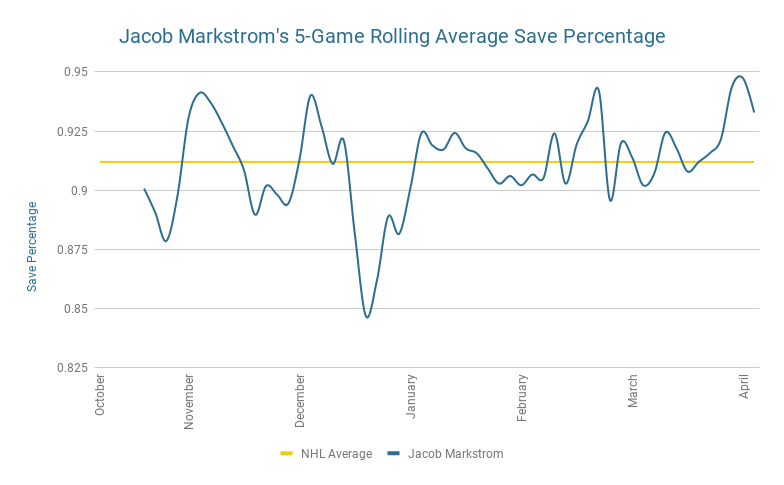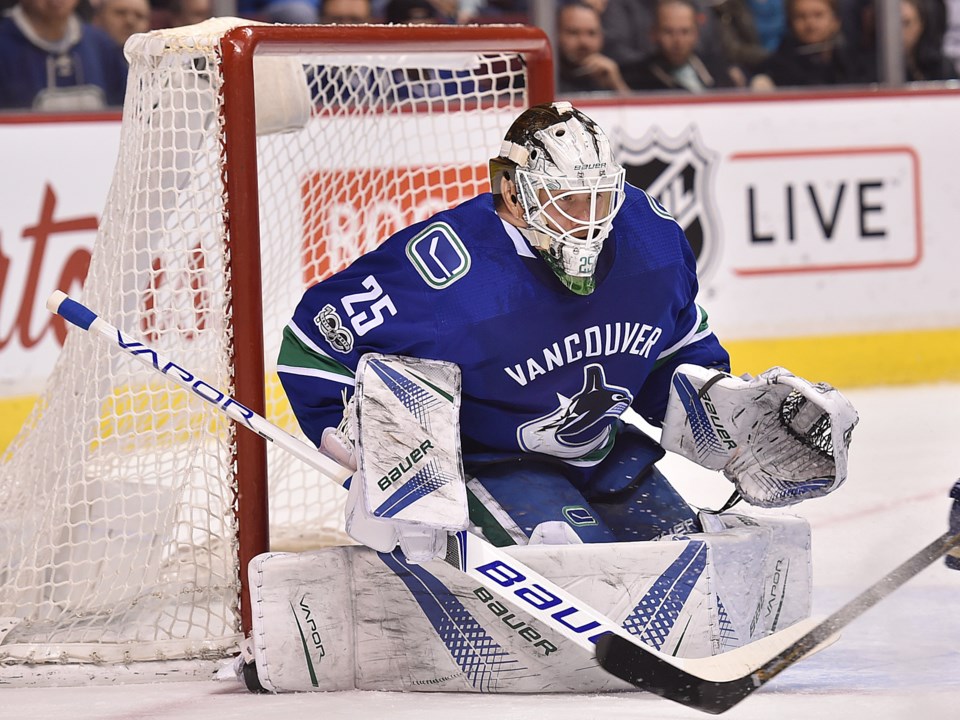In mid-March, the Canucks were within one point of last place in the NHL. At that time, I asked a simple question: would this season have been any different with better goaltending? It was a fair question to ask: both Jacob Markstrom and Anders Nilsson had struggled up to that point and were both below league-average in save percentage. The truth is, however, that better goaltending wouldn’t have been close to enough to make the Canucks a playoff team. They just had too many other issues.
A funny thing happened after that article was published, however: the Canucks went on a tear, rising from 30th to 26th, and it was largely because of Jacob Markstrom. In the six games he played after March 21st, Markstrom posted a .937 save percentage, which was enough to bring up his save percentage on the season to a league-average .912.
Yes, Markstrom managed a league-average save percentage despite playing more than 33 games for the first time in his career. For a goaltender taking on a starter’s role for the very first time, that’s actually pretty good.
Maintaining a league-average save percentage over the course of 60 games isn’t easy and the goaltenders that can manage to do so consistently year after year are rare. Can Markstrom perform at that level consistently?
Certainly, Markstrom had his issues this past season. Too often he would let in an early goal or a shot from a bad angle, but those goals were coloured by his low save percentage. Even a good goaltender gives up a bad goal, but it was particularly disheartening to see those goals go in when Markstrom was so far below average.
In his run to end the season, however, Markstrom was a legitimate difference maker. He made 39 saves against the Blackhawks on March 22nd, then went three straight starts where he only allowed one goal per game.

The question for the Canucks is whether Markstrom’s late-season run means anything. Is a small sample of six games enough to give the team confidence that Markstrom can be an improved goaltender next season? Is a league-average save percentage in his first year as a starter encouraging or is this the best that Markstrom can be?
“Me and Clouts [goaltending coach Dan Cloutier] made some changes,” said Markstrom at the end of the year. “I felt like I was way more relaxed in the crease and just instead of chasing the game, I let it come to me. So that’s something we hope to build for next year and this summer.”
“You work on it all year,” he continued. “I got really comfortable with it at the end on that road trip [where] we went to Vegas, St. Louis, Chicago...You try to make small changes the whole year and improvements, but I got really comfortable at the end of the season.”
Should it be concerning that Markstrom didn’t feel comfortable with the changes he and Cloutier were making in his game until the very end of the season? Or should that be encouraging for next season, with the hope that he can be comfortable right from puck drop in the season opener?
"I think the biggest challenge, too, the first half of the season, it was to kind of let bad games go and not bring it in to practice the next day or sit and think about it, you just have to drop it," said Markstrom. "Short memory. And even good games too, to leave it...When you don’t play so much, you play a game and then you sit a week or 10 days, it’s easier to sit and think about those games. When you play a lot, you really have to let it go quick."
Markstrom’s career numbers remain a concern. His career save percentage is just .908, though he has surpassed that in all three seasons with the Canucks. He posted a league-average save percentage of .915 in his first full season in Vancouver in 2015-16.
It’s worth noting that even with his league-average save percentage, he was still below average when it comes to more advanced goaltending metrics like Goals Saved Above Average (GSAA). At 5-on-5, Markstrom allowed 2.15 more goals against than a average goaltender based on the quality of shots he faced.
On the penalty kill, his -6.54 GSAA was fifth worst in the NHL, though the very good Andrei Vasilevskiy was even worse. It’s tough to say how much of a goaltender’s performance on the penalty kill is within his control, as shot quality generally depends on passes before shots that are not captured in GSAA.
Canucks goaltenders faced a difficult challenge this past season. According to Natural Stat Trick, the Canucks allowed the fourth most scoring chances against in the NHL at 5-on-5. With that in mind, maybe a league-average save percentage is a little more impressive than it looks.
There are still some major concerns with trusting Markstrom as the team’s number one goaltender heading into next season, but the truth is the Canucks don’t have much choice. Unless Thatcher Demko blows the Canucks’ minds in training camp next season, Markstrom will be the de facto starter. At this point, the Canucks just have top hope that he can start the season the way he ended this one.



